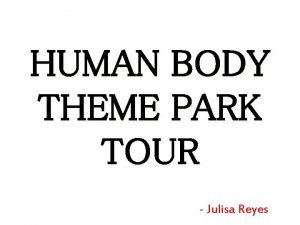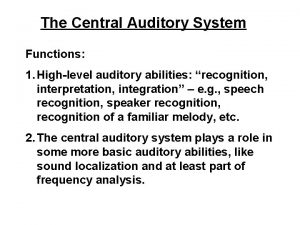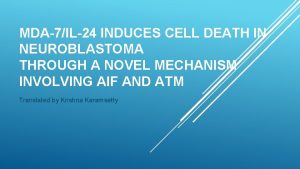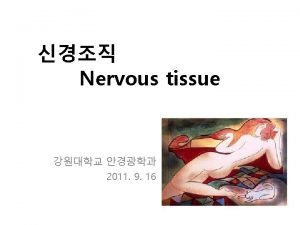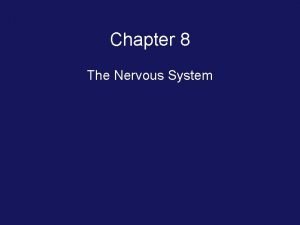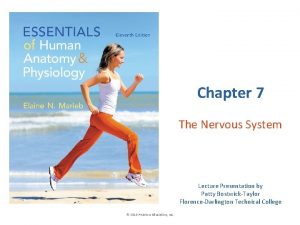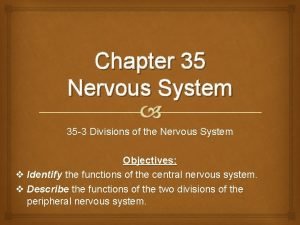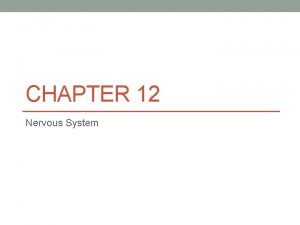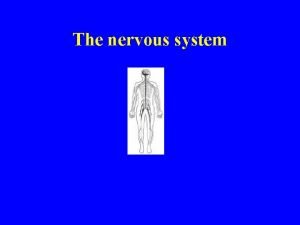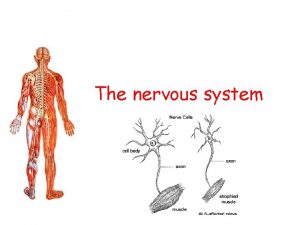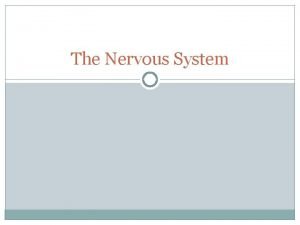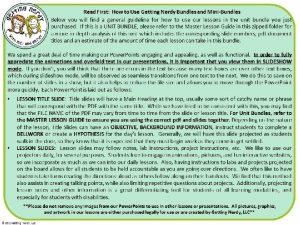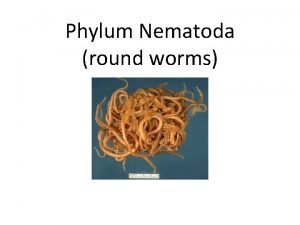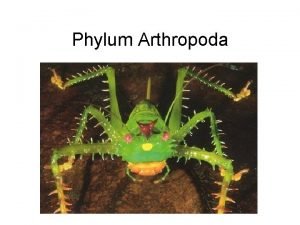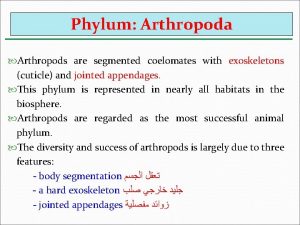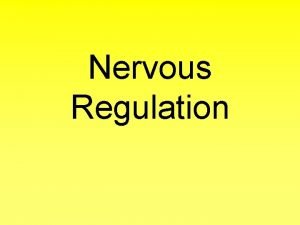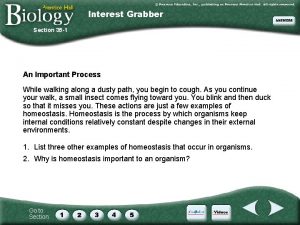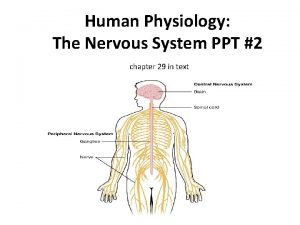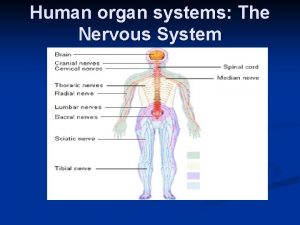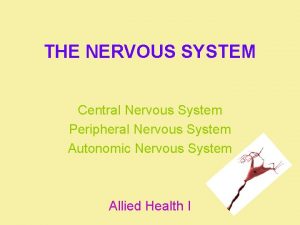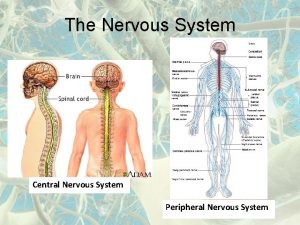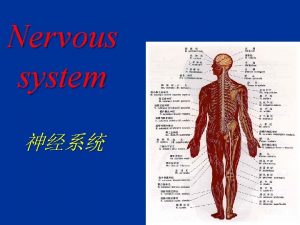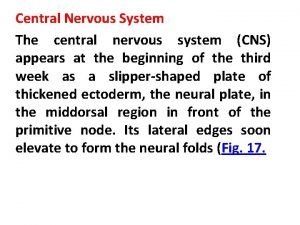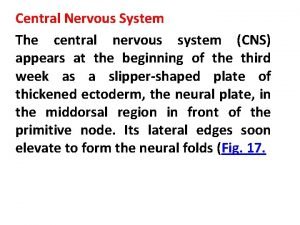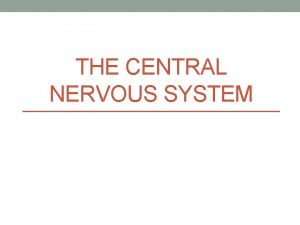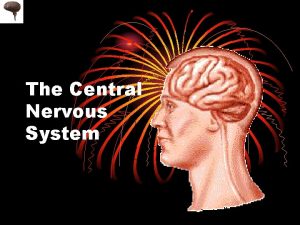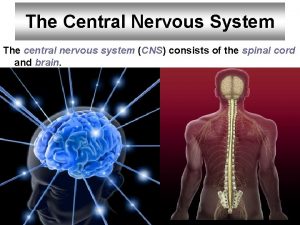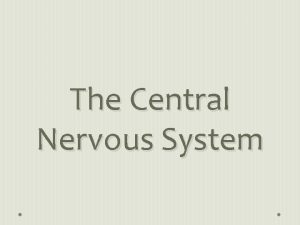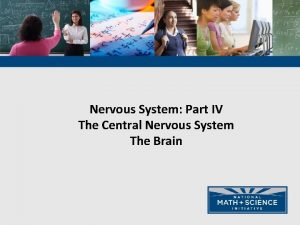Chapter 12 Part D The Central Nervous System















































- Slides: 47

Chapter 12 Part D The Central Nervous System © Annie Leibovitz/Contact Press Images © 2017 Pearson Education, Inc. Power. Point® Lecture Slides prepared by Karen Dunbar Kareiva Ivy Tech Community College

12. 10 Spinal Cord Gross Anatomy and Protection • Spinal cord is enclosed in vertebral column – Begins at the foramen magnum – Ends at L 1 or L 2 vertebra • Functions – Provides two-way communication to and from brain and body – Major reflex center: reflexes are initiated and completed at spinal cord © 2017 Pearson Education, Inc.

Gross Anatomy and Protection (cont. ) • Protected by bone, meninges, and CSF • Spinal dura mater is one layer thick – Does not attach to vertebrae • Epidural space – Cushion of fat and network of veins in space between vertebrae and spinal dura mater • CSF fills subarachnoid space between arachnoid and pia maters • Dural and arachnoid membranes extend to sacrum, beyond end of cord at L 1 or L 2 – Site of lumbar puncture or tap © 2017 Pearson Education, Inc.

Figure 12. 27 a Gross structure of the spinal cord, dorsal view. Cervical enlargement Dura and arachnoid mater Cervical spinal nerves Thoracic spinal nerves Lumbar enlargement Conus medullaris Cauda equina Filum terminale © 2017 Pearson Education, Inc. Lumbar spinal nerves Sacral spinal nerves The spinal cord and its nerve roots, with the bony vertebral arches removed. The dura mater and arachnoid mater are cut open and reflected laterally.

Figure 12. 28 Diagram of a lumbar puncture. T 12 L 5 Ligamentum flavum Lumbar puncture needle entering subarachnoid space L 4 Supraspinous ligament L 5 Filum terminale S 1 Intervertebral disc © 2017 Pearson Education, Inc. Arachnoid mater Dura mater Cauda equina in subarachnoid space

Gross Anatomy and Protection (cont. ) • Spinal cord terminates in cone-shaped structure called conus medullaris • Filum terminale extends to coccyx – Fibrous extension of conus covered with pia mater – Anchors spinal cord • Denticulate ligaments – Extensions of pia mater that secure cord to dura mater – Cervical and lumbar enlargements: areas where nerves servicing upper and lower limbs arise from spinal cord © 2017 Pearson Education, Inc.

Gross Anatomy and Protection (cont. ) • Spinal nerves – Part of PNS – Attach to spinal cord by 31 paired roots • Cervical and lumbosacral enlargements – Nerves serving upper and lower limbs emerge here • Cauda equina – Collection of nerve roots at inferior end of vertebral canal © 2017 Pearson Education, Inc.

Figure 12. 27 a Gross structure of the spinal cord, dorsal view. Cervical enlargement Dura and arachnoid mater Cervical spinal nerves Thoracic spinal nerves Lumbar enlargement Conus medullaris Cauda equina Filum terminale © 2017 Pearson Education, Inc. Lumbar spinal nerves Sacral spinal nerves The spinal cord and its nerve roots, with the bony vertebral arches removed. The dura mater and arachnoid mater are cut open and reflected laterally.

Figure 12. 27 b Gross structure of the spinal cord, dorsal view. Foramen magnum Terminus of medulla oblongata of brain Sectioned pedicles of cervical vertebrae Spinal nerve rootlets Dorsal median sulcus of spinal cord Cervical spinal cord. © 2017 Pearson Education, Inc.

Figure 12. 27 c Gross structure of the spinal cord, dorsal view. Vertebral arch (cut) Spinal cord Cut edge of dura mater Dorsal root ganglion Dorsal median sulcus Dorsal root Thoracic spinal cord. © 2017 Pearson Education, Inc.

Figure 12. 27 d Gross structure of the spinal cord, dorsal view. Spinal cord First lumbar vertebral arch (cut across) Conus medullaris Cauda equina Filum terminale Inferior end of spinal cord, showing conus medullaris, cauda equina, and filum terminale. © 2017 Pearson Education, Inc.

Spinal Cord Cross-sectional Anatomy • Two lengthwise grooves that run length of cord partially divide it into right and left halves – Ventral (anterior) median fissure – Dorsal (posterior) median sulcus • Gray matter is located in core, white matter outside • Central canal runs length of cord – Filled with CSF © 2017 Pearson Education, Inc.

Figure 12. 29 a Anatomy of the spinal cord. Epidural space (contains fat) Subdural space Subarachnoid space (contains CSF) Pia mater Arachnoid mater Dura mater Spinal meninges Bone of vertebra Dorsal root ganglion Body of vertebra Cross section of spinal cord and vertebra © 2017 Pearson Education, Inc.

Figure 12. 29 b Anatomy of the spinal cord. Dorsal funiculus White Ventral funiculus columns Lateral funiculus Dorsal root ganglion Spinal nerve Dorsal root (fans out into dorsal rootlets) Ventral root (derived from several ventral rootlets) Dorsal median sulcus Gray commissure Dorsal horn Gray Ventral horn matter Lateral horn Central canal Ventral median fissure Pia mater Arachnoid mater Spinal dura mater The spinal cord and its meningeal coverings © 2017 Pearson Education, Inc.

Spinal Cord Cross-sectional Anatomy (cont. ) • Gray matter and spinal roots – Cross section of cord resembles butterfly or letter “H” – Three areas of gray matter are found on each side of center and are mirror images: • Dorsal horns: interneurons that receive somatic and visceral sensory input • Ventral horns: some interneurons; somatic motor neurons • Lateral horns (only in thoracic and superior lumbar regions): sympathetic neurons © 2017 Pearson Education, Inc.

Spinal Cord Cross-sectional Anatomy (cont. ) • Gray matter and spinal roots (cont. ) – Gray commissure: bridge of gray matter that connects masses of gray matter on either side • Encloses central canal – Ventral roots: bundle of motor neuron axons that exit the spinal cord – Dorsal roots: sensory input to cord – Dorsal root (spinal) ganglia: cell bodies of sensory neurons – Spinal nerves: formed by fusion of dorsal and ventral roots © 2017 Pearson Education, Inc.

Spinal Cord Cross-sectional Anatomy (cont. ) • Gray matter and spinal roots (cont. ) – Gray matter divided into four groups based on of somatic or visceral innervation • Somatic sensory (SS), visceral sensory (VS), visceral (autonomic) motor (VM) and somatic motor (SM) © 2017 Pearson Education, Inc.

Figure 12. 30 Organization of the gray matter of the spinal cord. Dorsal root (sensory) Somatic sensory neuron Dorsal horn (interneurons) Dorsal root ganglion SS VS VM SM Visceral sensory neuron Visceral motor neuron Somatic motor neuron Spinal nerve Ventral root (motor) Ventral horn (motor neurons) SS Interneurons receiving input from somatic sensory neurons VS Interneurons receiving input from visceral sensory neurons VM Visceral motor (autonomic) neurons SM Somatic motor neurons © 2017 Pearson Education, Inc.

Spinal Cord Cross-sectional Anatomy (cont. ) • White matter – Myelinated and nonmyelinated nerve fibers allow communication between parts of spinal cord, and spinal cord and brain – Run in three directions • Ascending: up to higher centers (sensory inputs) • Descending: from brain to cord or lower cord levels (motor outputs) • Transverse: from one side to other (commissural fibers) © 2017 Pearson Education, Inc.

Spinal Cord Cross-sectional Anatomy (cont. ) • White matter is divided into three white columns (funiculi) on each side – Dorsal (posterior) – Lateral – Ventral (anterior) • Each spinal tract is composed of axons with similar destinations and functions © 2017 Pearson Education, Inc.

Figure 12. 29 b Anatomy of the spinal cord. Dorsal funiculus White Ventral funiculus columns Lateral funiculus Dorsal root ganglion Spinal nerve Dorsal root (fans out into dorsal rootlets) Ventral root (derived from several ventral rootlets) Dorsal median sulcus Gray commissure Dorsal horn Gray Ventral horn matter Lateral horn Central canal Ventral median fissure Pia mater Arachnoid mater Spinal dura mater The spinal cord and its meningeal coverings © 2017 Pearson Education, Inc.

Figure 12. 31 Major ascending (sensory) and descending (motor) tracts of the spinal cord, cross-sectional view. Ascending tracts Dorsal white column • Fasciculus gracilis • Fasciculus cuneatus Spinocerebellar tracts • Dorsal • Ventral Spinothalamic tracts • Lateral • Ventral Descending tracts Ventral white commissure Corticospinal tracts (pyramidal tracts) • Lateral • Ventral Rubrospinal tract Reticulospinal tracts • Medial • Lateral Vestibulospinal tract Tectospinal tract © 2017 Pearson Education, Inc.

Spinal Cord Trauma and Disorders • Spinal cord trauma – Localized injury to spinal cord or its roots leads to functional losses • Paresthesias: caused by damage to dorsal roots or sensory tracts – Leads to sensory function loss • Paralysis: caused by damage to ventral roots or ventral horn cells – Leads to motor function loss – Two types of paralysis: flaccid or spastic © 2017 Pearson Education, Inc.

Spinal Cord Trauma and Disorders (cont. ) • Spinal cord trauma (cont. ) – Flaccid paralysis: severe damage to ventral root or ventral horn cells • Impulses do not reach muscles; there is no voluntary or involuntary control of muscles • Muscles atrophy – Spastic paralysis: damage to upper motor neurons of primary motor cortex • Spinal neurons remain intact; muscles are stimulated by reflex activity • No voluntary control of muscles • Muscles often shorten permanently © 2017 Pearson Education, Inc.

Spinal Cord Trauma and Disorders (cont. ) • Spinal cord trauma (cont. ) – Transection (cross sectioning) of spinal cord at any level results in total motor and sensory loss in regions inferior to cut • Paraplegia: transection between T 1 and L 1 • Quadriplegia: transection in cervical region – Spinal shock: transient period of functional loss caudal to lesion © 2017 Pearson Education, Inc.

Spinal Cord Trauma and Disorders (cont. ) • Poliomyelitis – Destruction of ventral horn motor neurons by poliovirus – Muscles atrophy – Death may occur from paralysis of respiratory muscles or cardiac arrest – Survivors often develop postpolio syndrome many years later from neuron loss © 2017 Pearson Education, Inc.

Spinal Cord Trauma and Disorders (cont. ) • Amyotrophic lateral sclerosis (ALS) – Also called Lou Gehrig’s disease – Destruction of ventral horn motor neurons and fibers of pyramidal tract – Symptoms: loss of ability to speak, swallow, and breathe – Death typically occurs within 5 years – Caused by environmental factors and genetic mutations involving RNA processing • Involves glutamate excitotoxicity © 2017 Pearson Education, Inc.

Spinal Cord Trauma and Disorders (cont. ) • Amyotrophic lateral sclerosis (ALS) (cont. ) – Drug riluzole interferes with glutamate signaling: only treatment © 2017 Pearson Education, Inc.

12. 11 Neuronal Pathways • Major spinal tracts are part of multineuron pathways • Four key points about spinal tracts and pathways: – Decussation: Most pathways cross from one side of CNS to other at some point – Relay: Consist of chain of two or three neurons – Somatotopy: precise spatial relationship in CNS correspond to spatial relationship in body – Symmetry: pathways are paired symmetrically (right and left) © 2017 Pearson Education, Inc.

Ascending Pathways • Conduct sensory pathways upward through a chain of three neurons: – First-order neuron • Conducts impulses from cutaneous receptors and proprioceptors • Branches diffusely as it enters spinal cord or medulla • Synapses with second-order neuron © 2017 Pearson Education, Inc.

Ascending Pathways (cont. ) – Second-order neuron • Interneuron • Cell body in dorsal horn of spinal cord or medullary nuclei • Axons extend to thalamus or cerebellum – Third-order neuron • • Also an interneuron Cell bodies in thalamus Axon extends to somatosensory cortex No third-order neurons in cerebellum © 2017 Pearson Education, Inc.

Ascending Pathways (cont. ) • Somatosensory signals travel along three main pathways on each side of spinal cord: – Two pathways transmit somatosensory information to sensory cortex via thalamus • Dorsal column–medial lemniscal pathways • Spinothalamic pathways • Provide for discriminatory touch and conscious proprioception – Third pathway, spinocerebellar tracts, terminate in the cerebellum © 2017 Pearson Education, Inc.

Ascending Pathways (cont. ) – Dorsal column–medial lemniscal pathways • Transmit input to somatosensory cortex for discriminative touch and vibrations • Composed of paired fasciculus cuneatus and fasciculus gracilis in spinal cord and medial lemniscus in brain (medulla to thalamus) – Spinothalamic pathways • Lateral and ventral spinothalamic tracts • Transmit pain, temperature, coarse touch, and pressure impulses within lateral spinothalamic tract © 2017 Pearson Education, Inc.

Ascending Pathways (cont. ) – Spinocerebellar tracts • Ventral and dorsal tracts • Convey information about muscle or tendon stretch to cerebellum – Used to coordinate muscle activity © 2017 Pearson Education, Inc.

Figure 12. 32 a Pathways of selected ascending spinal cord tracts. Primary somatosensory cortex Axons of third-order neurons Thalamus Cerebrum Midbrain Cerebellum Pons Dorsal spinocerebellar tract (axons of second-order neurons) Medial lemniscus (tract) (axons of second-order neurons) Nucleus gracilis Nucleus cuneatus Medulla oblongata Fasciculus cuneatus (axon of first-order sensory neuron) Axon of first-order neuron Muscle spindle (proprioceptor) Joint stretch receptor (proprioceptor) Cervical spinal cord Fasciculus gracilis (axon of first-order sensory neuron) Lumbar spinal cord Touch receptor Spinocerebellar pathway © 2017 Pearson Education, Inc. Dorsal column–medial lemniscal pathway

Figure 12. 32 b Pathways of selected ascending spinal cord tracts. Primary somatosensory cortex Axons of third-order neurons Thalamus Cerebrum Midbrain Cerebellum Pons Medulla oblongata Lateral spinothalamic tract (axons of second-order neurons) Pain receptors Cervical spinal cord Axons of first-order neurons Temperature receptors Lumbar spinal cord Spinothalamic pathway © 2017 Pearson Education, Inc.

Table 12. 2 -1 Major Ascending (Sensory) Pathways and Spinal Cord Tracts © 2017 Pearson Education, Inc.

Table 12. 2 -2 Major Ascending (Sensory) Pathways and Spinal Cord Tracts (continued) © 2017 Pearson Education, Inc.

Table 12. 2 -3 Major Ascending (Sensory) Pathways and Spinal Cord Tracts (continued) © 2017 Pearson Education, Inc.

Descending Pathways and Tracts • Deliver efferent impulses from brain to spinal cord • Two groups – Direct pathways: pyramidal tracts – Indirect pathways: all others • Motor pathways involve two neurons: – Upper motor neurons • Pyramidal cells in primary motor cortex – Lower motor neurons • Ventral horn motor neurons • Innervate skeletal muscles © 2017 Pearson Education, Inc.

Descending Pathways and Tracts (cont. ) • Direct (pyramidal) pathways – Impulses from pyramidal neurons in precentral gyri pass through pyramidal (lateral and ventral corticospinal) tracts – Descend directly without synapsing until axon reaches end of tract in spinal cord – In spinal cord, axons synapse with interneurons (lateral tract) or ventral horn motor neurons (ventral tract) – Direct pathway regulates fast and fine (skilled) movements © 2017 Pearson Education, Inc.

Figure 12. 33 a Three descending pathways by which the brain influences movement. Pyramidal cells (upper motor neurons) Primary motor cortex Internal capsule Cerebrum Midbrain Cerebral peduncle Cerebellum Pons Ventral corticospinal tract Pyramids Decussation of pyramids Lateral corticospinal tract Medulla oblongata Cervical spinal cord Skeletal muscle Lumbar spinal cord Somatic motor neurons (lower motor neurons) Pyramidal (lateral and ventral corticospinal) pathways © 2017 Pearson Education, Inc.

Descending Pathways and Tracts (cont. ) • Indirect pathways – Also referred to as multineuronal pathways – Complex and multisynaptic – Includes brain stem motor nuclei and all motor pathways except pyramidal pathways – These pathways regulate: • Axial muscles, maintaining balance and posture • Muscles controlling coarse limb movements • Head, neck, and eye movements that follow objects in visual field © 2017 Pearson Education, Inc.

Descending Pathways and Tracts (cont. ) • Indirect pathways (cont. ) – Consist of four major pathways: • Reticulospinal and vestibulospinal tracts: – maintain balance by varying tone of postural muscles • Rubrospinal tracts: control flexor muscles • Tectospinal tracts: originate from superior colliculi and mediate head movements in response to visual stimuli © 2017 Pearson Education, Inc.

Figure 12. 33 b Three descending pathways by which the brain influences movement. Cerebrum Red nucleus Midbrain Cerebellum Pons Rubrospinal tract Medulla oblongata Cervical spinal cord Rubrospinal tract © 2017 Pearson Education, Inc.

Table 12. 3 -1 Major Descending (Motor) Pathways and Spinal Cord Tracts © 2017 Pearson Education, Inc.

Table 12. 3 -2 Major Descending (Motor) Pathways and Spinal Cord Tracts (continued) © 2017 Pearson Education, Inc.
 Central nervous system diagram
Central nervous system diagram Neuronal pools
Neuronal pools Sensory input and motor output
Sensory input and motor output Processes of nerve cell
Processes of nerve cell Central and peripheral nervous system
Central and peripheral nervous system Central nervous system amusement park
Central nervous system amusement park Nervous system vocabulary
Nervous system vocabulary Hydra neurons
Hydra neurons Bser aer
Bser aer Central nervous system divisions
Central nervous system divisions Central nervous system for kids
Central nervous system for kids Nervous system and digestive system
Nervous system and digestive system Endocrine system and nervous system
Endocrine system and nervous system Mechanism of action of hormones
Mechanism of action of hormones Endocrine system
Endocrine system Central nervous sysytem
Central nervous sysytem Chapter 7 the nervous system
Chapter 7 the nervous system Chapter 15 nervous system diseases and disorders
Chapter 15 nervous system diseases and disorders Chapter 8 the nervous system
Chapter 8 the nervous system Chapter 7 the nervous system figure 7-2
Chapter 7 the nervous system figure 7-2 Chapter 35 nervous system
Chapter 35 nervous system Chapter 14 the skeletal muscular and nervous systems
Chapter 14 the skeletal muscular and nervous systems Chapter 12 nervous system
Chapter 12 nervous system Chemical messengers of the nervous system
Chemical messengers of the nervous system Platyhelminthes vs nematoda
Platyhelminthes vs nematoda The nervous system is made up of
The nervous system is made up of Primary functions of the nervous system
Primary functions of the nervous system Nervous system learning objectives
Nervous system learning objectives What is stimuli in nervous system
What is stimuli in nervous system Nervous system objectives
Nervous system objectives Autonomic nervous system visceral
Autonomic nervous system visceral Parasympathetic
Parasympathetic Spinal cord 31 pairs
Spinal cord 31 pairs Sns somatic nervous system
Sns somatic nervous system Brain scienstructable
Brain scienstructable Somatic motor neuron
Somatic motor neuron Roundworms nervous system
Roundworms nervous system Arthropoda insecta
Arthropoda insecta Jointed foot
Jointed foot Segmented coelomates
Segmented coelomates Parasympathatic nervous system
Parasympathatic nervous system Coelenterata nervous system
Coelenterata nervous system Autonomic nervous system consists of
Autonomic nervous system consists of The body's speedy electrochemical communication network
The body's speedy electrochemical communication network Section 35-5 drugs and the nervous system answer key
Section 35-5 drugs and the nervous system answer key Autonomic nervous system pathway
Autonomic nervous system pathway The nervous system
The nervous system Basic unit of nervous system
Basic unit of nervous system





